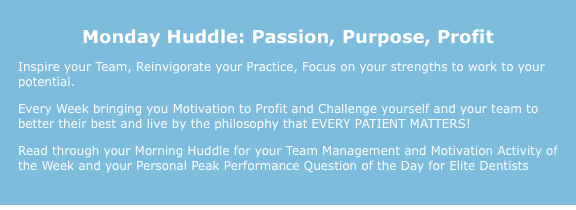The most common ‘challenge’ that is asked about from more teams more often than any other is absolutely, hands down: communication.
Of course, the real challenge to this ‘challenge’ is that everyone means something different by “communication.”
You might mean communication front to back or back to front.
You might mean patients understanding their treatment when the exit.
You might mean not having clarity of the doctor’s expectations.
You might mean literally the team not communicating period.
So, today, in this week’s Monday Huddle, we are going to begin with the end in mind and we are going to set you and your team up for success when it comes to your communication strategy.
Can you believe I just used that word? Strategy. Why would I do that?
Because communication is like anything else, it’s not going to happen effectively on accident. There must be a plan and an approach in place that you can all work with and agree on.
There are two parts to this.
One: allowing time for communication and having structured protocols with clear expectations.
That means you want to have disciplined Huddles where each person knows what the expected contributions are, every day.
This is why we want a morning and an evening Huddle in some way, shape or form. So that there are always checks-and-balances with forced communication structure which leads to more organized execution.
This is all fundamental, easy, you do this already. The key is: how is it working? What could be better? Where does your effectiveness wane? What do you accomplish or not accomplish in your communication structure and why?
I want you to assess every meeting and communication protocol you have to see where you can enhance the outcome.
Remember – it’s not about your convenience – it’s about your outcomes. Does everything you do and talk about lead to scoring more points, getting more yeses, collecting more money, turning more production and helping more patients?
Which leads me to…
Two: identify where communication breaks down – in your process flow, treatment flow, patient flow, schedule flow, etc – in every part of the practice.
The only want to know this is to ask each and every team member (and technically to even survey your patients but this is a good start) and let each person talk about from their perspective where they feel they are missing information, left in the dark, unsure about something, guessing on others, etc.
Now, some may not have much to say, others may have a lot.
This goes far beyond just understanding what each other does, though that is important. This is about making sure that there are no broken lines of communication or places where its inadequate in serving it’s purpose of achieving the desired outcome.
When you go around the room, make a list of the specific places where communication breaks down and/or where it can be improved. Send me a copy and I’ll address the most common areas.
Next week, we dive deep into the ways you can improve your communication with patients by slowing down the experience and getting them to be more involved in your process (which will actually help with today’s topic as well).
By the way, when you fix the communication breakdowns within your team, you will be amazed at how much more treatment you will close and money you will collect – patients get lost in the shuffle whether you believe it or want to admit it or not.
This list you made, after sending it to me, ought to get taped up on the wall to hold everyone accountable and cease making the same mistakes over and over.



